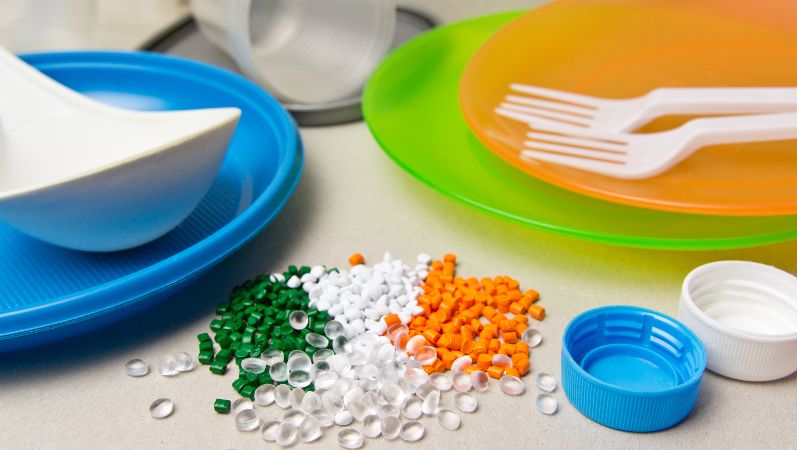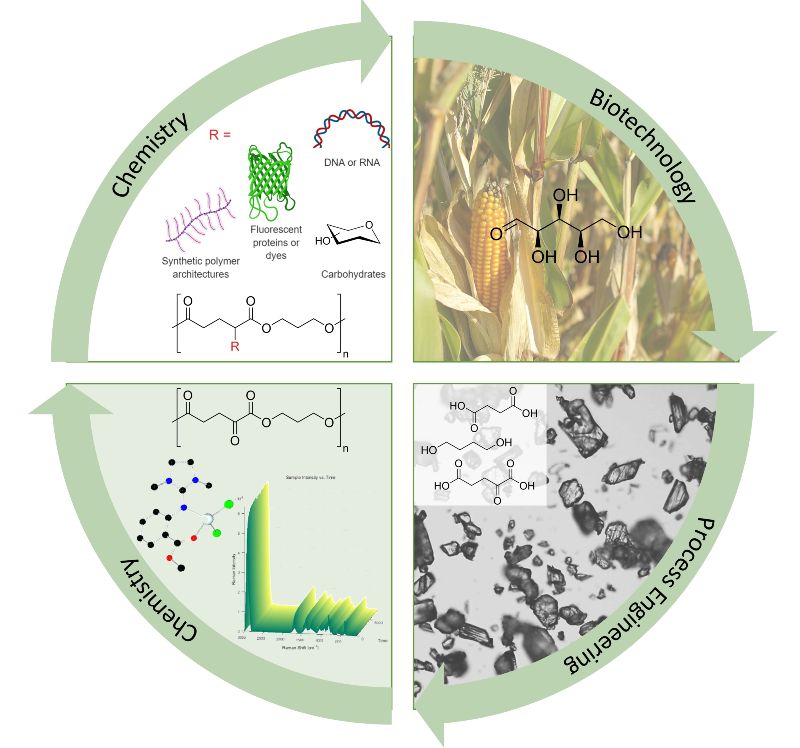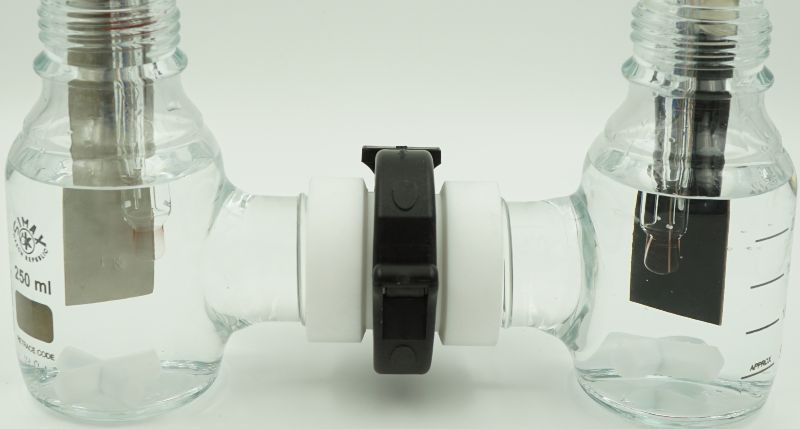
The R2HPBio project pursued an integrative approach along the entire value chain for the production of bioplastics. A specially developed crystallization process purifies a range of potential platform chemicals from a fermentation broth. Using novel catalysts, these are processed to plastics that can be given customized characteristics through subsequent modifications. The resulting materials are biodegradable, can be produced from renewable resources and have potential for a variety of practical applications.
R2HPBio covers the entire life cycle of novel bioplastics. The project is closely linked to the HyImPAct FocusLab that produces important platform chemicals from renewable resources and offers subsequent purification. In the framework of the R2HPBio project, platform chemicals were purified using modern, electrochemically induced separation methods to convert these to linear, bifunctional polyesters with robust metal complex catalysts. Subsequently, the bioplastics were optimized for specific applications by functionalization and investigated for their degradability.

Reducing costs
The platform molecules produced in the HyImPAct FocusLab such as succinic acid, 1,4-butanediol and protocatechuic acid are promising monomers for novel bioplastics. However, purification of these molecules from aqueous fermentation media is complex and cost-intensive. The R2HPBio established a new purification method based on the fact that carboxylic acids such as succinic acid and protocatechuic acid have a lower solubility at lower pH values and can be extracted. Electrochemical separation methods are a novel procedure for the separation of these carboxylic acids since the pH value can be adjusted specifically without additional additives such as hydrochloric acid or sodium hydroxide.
Neutral compounds cannot be separated as easily as salts. Therefore, the formation of carboxylates is induced by lowering pH using water splitting and the formation of neutral salts is avoided. For optimal separation, measuring the pH-dependent balance between dissolved and precipitated substance is essential. An automated installation was developed to measure the solubility of carboxylic acids in aqueous media for different temperatures and pH values. These data allowed the interpretation and implementation of electrochemically induced crystallization of succinic acid and protocatechuic acid.
Controlled growing
For the production of bioplastics, the purified monomers are converted into the desired polyesters in the next step via polycondensation. Polycondensation is a stepwise growth reaction of molecules. In this process, bifunctional monomers or already formed oligomers, i.e. more than one molecule already accumulated spontaneously, react to form linear polymers by splitting off low-molecular compounds such as water. This project converted the monomers succinic acid and 1,4-butanediol to the known polyester polybutylene succinate.

A customized, biocompatible zinc catalyst was used as the catalyst. What is special in the use of a specific metal complex is not only its biocompatibility but also its robustness against water formed during polymerization. The complex thus allows the synthesis of long chains. The objective is to initially produce medium-sized polyester chains, which then will be extended to biodegradable polyurethane. Cold-foam mattresses, thermal insulting panels or dishwashing sponges consist of polyurethanes, for example. This plastic is very difficult to recycle in its previous oil-based form.
Environmentally friendly production
Another sub-project developed a new, robust zinc-bisguanidine catalyst for the polymerization of the renewable monomers
lactide and e-caprolactone. Both cyclic monomers can be transformed into the biodegradable polyesters polylactide and polycaprolactone by catalytic ring-opening polymerization Polylactide is currently one of the most commonly produced bioplastics. The catalyst most widely used in industry in the polymerization of lactide is a complex containing the metal tin, which is harmful to cells. The catalyst, which only controls the reaction and is not used up, is difficult to remove from the polymer. Thus, the catalyst remains in the plastic for economic reasons. The plastic, which can be degraded to 90 percent within 90 days under industrial composting conditions, leaves the toxic metal in the compost and thus constitutes a threat to the environment.

The zinc catalyst developed in this cooperation represents a good alternative not only due to its non-toxic characteristics. In addition, the zinc catalyst exceeds the polymerization rate of the industrial used complex many times over. This was investigated using Raman spectroscopy, a method that follows the reaction to polymer in a time-resolved manner. Hereby, a colorless, long-chain polymer with high molar masses is formed. In addition, polymers produced with the zinc catalyst show high crystallinities, which are especially advantageous for medical applications such as artificial shoulder bones and bone screws, since the higher crystalline content in polylactide causes greater stability in an aqueous environment. In the medical field, the slow degradation of the bioplastics to lactic acid takes place after months or years, depending on the material characteristics, making a second surgical intervention unnecessary. If the bioplastics are used in packaging, they are expected to degrade or be recycled more quickly. Here it was shown that zinc-guanidine complexes excellently catalyze not only simple degradation to lactic acid but also the reaction to other platform chemicals, such as ethyl acetate, as a recycling step. In this way, the renewable resource can be used several times in the sense of a recycling economy and additional waste is avoided.
The R2HPBio project thus took a central step towards a circular bioeconomy through interdisciplinary cooperation, which will establish the sustainable bioeconomy in the long term.
Project Coordinator
Prof. Dr. Sonja Herres-Pawlis
Chair of Bioinorganic Chemistry, RWTH Aachen
Email
Participating Core Groups
Prof. Dr. Sonja Herres-Pawlis, Alina Herrmann
Chair of Bioinorganic Chemistry, RWTH Aachen
Prof. Dr. Andreas Jupke, Jonas Görtz
AVT – Fluid Process Engineering, RWTH Aachen
Prof. Dr. Laura Hartmann, Dr. Stephen Hill
Chair of Macromolecular Chemistry, HHU Düsseldorf
Funding Period
01.10.2018 - 31.12.2020
Funding
R2HPBio is part of the NRW-Strategieprojekt BioSC and thus funded by the Ministry of Culture and Science of the German State of North Rhine-Westphalia.
Publications
Abdelshafy, A, Hermann, A, Herres-Pawlis, S and Walther, G (2023). Opportunities and Challenges of Establishing a Regional Bio-based Polylactic Acid Supply Chain. Global Challenges 7(7): 2200218.
Tenhaef, N, Hermann, A, Müller, MF, Görtz, J, Marienhagen, J, Oldiges, M, Wiechert, W, Bott, M, Jupke, A, Hartmann, L, Herres-Pawlis, S and Noack, S (2023). From Microbial Succinic Acid Production to Polybutylene Bio-Succinate Synthesis Chemie Ingenieur Technik 95(4): 587-595.
Hermann, A, Becker, T, Schäfer, MA, Hoffmann, A and Herres-Pawlis, S (2022). Effective Ligand Design: Zinc Complexes with Guanidine Hydroquinoline Ligands for Fast Lactide Polymerization and Chemical Recycling. ChemSusChem 15(18): e202201075.